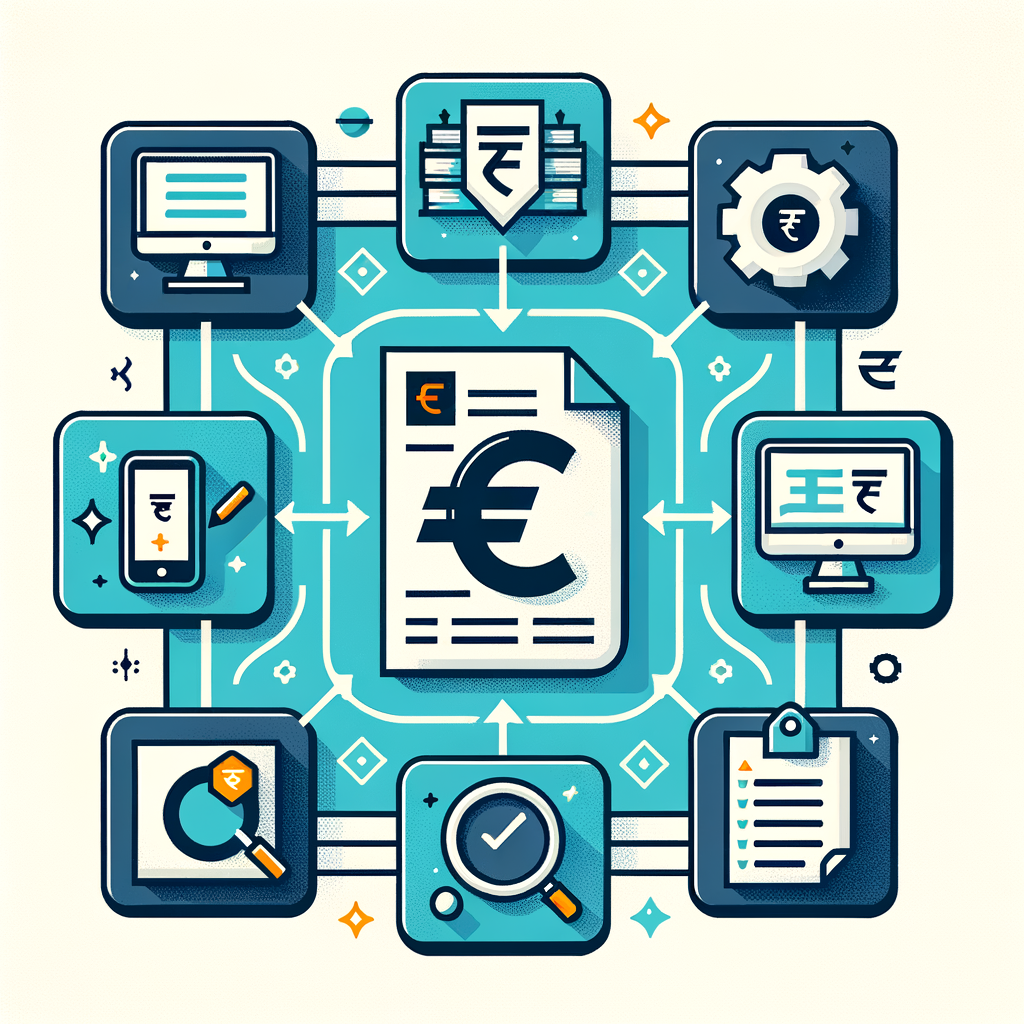Understanding the Role of E-Invoicing in GST Return Filings
The end of the month often brings a familiar sense of dread for many Indian business owners: it’s time to file GST returns. The process can be a maze of data entry, invoice matching, and reconciliation, with the constant fear of making costly errors. However, a significant transformation in the Indian GST regime is changing this narrative. This is where we need to understand the e-invoicing role in GST filing. Far from being just another compliance hurdle, e-invoicing is a powerful system designed to make your GST journey simpler, faster, and remarkably more accurate. This guide will demystify e-invoicing, explaining what it is, its direct and game-changing impact on your GST returns, its broader benefits, and how you can ensure seamless compliance.
What is E-Invoicing? A Simple Breakdown for Indian Businesses
Before we dive into its impact on GST returns, it’s crucial to understand what e-invoicing truly is. It’s a common misconception that e-invoicing simply means generating a PDF of your invoice and emailing it to your customer. The reality is far more sophisticated and integrated.
Beyond a Digital Bill: The Core Concept of E-Invoicing
E-invoicing, under the Indian GST framework, is a system where B2B (Business-to-Business) invoices are electronically authenticated by the Goods and Services Tax Network (GSTN) in real-time before they are shared with the customer. This process introduces a layer of validation at the very source of the transaction.
Here are the core components you need to know:
- Invoice Registration Portal (IRP): This is the government-managed portal that acts as the central registrar for all B2B invoices. When you upload your invoice data, the IRP is responsible for validating it.
- Invoice Reference Number (IRN): Once the IRP validates your invoice data and confirms it is unique, it generates a 64-character unique hash known as the Invoice Reference Number (IRN). This IRN is the unique identity for your e-invoice for its entire lifecycle.
- Signed QR Code: Along with the IRN, the IRP also digitally signs the invoice details and embeds them into a QR (Quick Response) code. This QR code, which must be printed on the final invoice, contains key details like the GSTINs of the supplier and recipient, invoice number, date, value, and the IRN. This allows tax officers and customers to verify the invoice’s authenticity instantly.
Who Needs to Comply with E-Invoicing?
The mandate for e-invoicing is based on a business’s aggregate annual turnover. The government has been rolling out this requirement in phases, gradually lowering the turnover threshold to bring more businesses into the fold.
Currently, e-invoicing is mandatory for all registered businesses with an aggregate annual turnover exceeding ₹5 Crores in any preceding financial year from 2017-18 onwards.
It’s vital to stay updated on these limits, as they are subject to change. For the most current information on turnover limits and applicability, you can refer to the official GST portal. Ensuring e-invoicing compliance for businesses is not just a regulatory requirement but a step towards modernizing your financial processes.
The Critical E-Invoicing Role in GST Filing Automation
This is where the true power of the system becomes clear. The primary e-invoicing role in GST filing is to create a direct, automated link between your daily invoicing activities and your monthly tax return obligations. It effectively eliminates the cumbersome manual steps that were previously the main source of errors and delays.
Automatic Population of GSTR-1 and GSTR-2B
Here’s the magic of the system: the moment your invoice is successfully validated and an IRN is generated by the IRP, a digital chain reaction is set in motion. The IRP securely pushes this authenticated invoice data directly to the main GST portal. This data is then used to auto-populate key sections of your GST returns.
- For the Supplier: The details from your e-invoices (like invoice number, date, value, tax amounts, and recipient’s GSTIN) are automatically filled into the relevant tables of your Form GSTR-1, which is your statement of outward supplies. This means you no longer have to manually enter hundreds of invoices each month.
- For the Recipient: Simultaneously, this same verified data appears in the recipient’s Form GSTR-2A (a dynamic, real-time view) and Form GSTR-2B (a static statement for the period). This provides the recipient with a clear and validated record of their inward supplies.
Eliminating Manual Errors and Reconciliation Headaches
Before e-invoicing, businesses spent countless hours manually typing invoice data into their GSTR-1 forms. This manual process was prone to human errors—a wrong digit in a GSTIN, an incorrect invoice value, or a misplaced tax amount could lead to serious compliance issues, tax notices, and painful reconciliation cycles. Understanding How to Correct Errors in Your GST Returns was a critical, time-consuming skill.
The link between e-invoicing and GST returns solves this by establishing a single source of truth. Since the data flows directly from a government-validated source (the IRP) to the GST portal, the possibility of data entry errors is virtually eliminated. This drastically reduces the mismatches between what the supplier reports in GSTR-1 and what the recipient has in their purchase records.
Facilitating Faster and Accurate Input Tax Credit (ITC) Claims
For the business receiving the goods or services, the most significant benefit is the newfound confidence in claiming Input Tax Credit (ITC). ITC is the cornerstone of the GST system, allowing businesses to reduce their tax liability.
Because the details of inward supplies in GSTR-2B are now populated directly from the supplier’s authenticated e-invoices, the recipient can be certain that the invoices are genuine and have been reported to the government. This reliability allows businesses to claim their eligible ITC faster and with greater accuracy, which directly translates to improved working capital and better cash flow management. The entire system underscores the Role of E-Invoicing in Streamlining ITC Claims.
The E-Invoicing Process in India: A Step-by-Step Guide
While the backend technology is complex, the user-facing e-invoicing process in India is designed to be straightforward and integrate with existing business workflows. You can follow our detailed guide on the Step-by-Step Process to Generate an e-Invoice and IRN. Here is a simplified breakdown of the steps involved:
- Step 1: Invoice Generation: The supplier creates a standard invoice using their existing ERP, accounting, or billing software. It is crucial that the software is configured to include all mandatory fields required for e-invoicing as per the official schema.
- Step 2: JSON Upload: The software automatically converts the invoice data into a specific machine-readable format called JSON (JavaScript Object Notation). This JSON file is then uploaded to the Invoice Registration Portal (IRP), either directly or through a GST Suvidha Provider (GSP).
- Step 3: IRP Validation: The IRP’s system receives the JSON file and performs a series of validations. It checks for errors, confirms that all mandatory fields are present, and ensures that the same invoice has not been uploaded before by checking against the Central Registry of the GST system.
- Step 4: IRN & QR Code Generation: Upon successful validation, the IRP generates the unique Invoice Reference Number (IRN), digitally signs the JSON file, and creates a QR code containing the key invoice details.
- Step 5: Final Invoice to Customer: The IRP sends the digitally signed JSON, along with the IRN and QR code, back to the supplier’s software. The software then embeds the QR code onto the invoice. This final invoice, now featuring the printed QR code, is sent to the customer. The entire process, from upload to receiving the signed JSON, typically takes less than a few seconds.
Understanding E-Invoicing Benefits India-Wide: More Than Just Compliance
The importance of e-invoicing India extends far beyond simplifying GST returns for individual businesses. It is a foundational reform that strengthens the entire tax ecosystem. By understanding e-invoicing benefits India-wide, businesses can appreciate its role in creating a more transparent and efficient economy.
For Your Business: Greater Efficiency and Transparency
The advantages for your business are immediate and tangible:
- Reduced Manual Work: Automation of GSTR-1 preparation saves significant time and resources.
- Minimized Errors: Eliminating manual data entry leads to higher accuracy in tax filings.
- Faster ITC Claims: Your customers can claim ITC faster, improving your business relationships and their cash flow.
- Interoperability: E-invoices are created in a standard format, meaning they can be read by any compliant software, streamlining B2B transaction processing and reducing disputes.
For the Tax System: Curbing Tax Evasion
From the government’s perspective, e-invoicing is a powerful tool to enhance tax compliance and curb evasion.
- Real-Time Tracking: Tax authorities get access to transaction data as it happens, rather than waiting until the end of the month.
- Preventing Fake Invoices: Since every invoice is registered with the IRP, it becomes extremely difficult for fraudulent businesses to create fake invoices solely for the purpose of claiming illegal ITC. This helps plug major tax leakages and ensures a level playing field for honest taxpayers.
Conclusion: Embrace E-Invoicing for Seamless GST Compliance
In conclusion, the primary e-invoicing role in GST filing is to act as a bridge, transforming a fragmented, manual process into a cohesive, automated, and error-free ecosystem. It is the backbone of a system that promises greater accuracy in your returns, faster processing of your customers’ input tax credits, and unparalleled transparency for the entire tax administration. By embracing this digital shift, you are not just meeting a regulatory requirement; you are unlocking significant operational efficiencies for your business.
Navigating e-invoicing compliance for businesses and integrating it into your existing systems can seem challenging at first. If you need help understanding the requirements, choosing the right software, or managing your GST returns seamlessly, the experts at TaxRobo are here to guide you. Contact us today for a consultation!
Frequently Asked Questions (FAQs)
Q1. What happens if I miss the 24-hour window to cancel an e-invoice?
A: An e-invoice cannot be cancelled on the IRP after the time limit for cancellation has lapsed (currently within 24 hours of generation). If you need to nullify an invoice after this period, you must issue a corresponding debit or credit note for that invoice and report it accordingly in your GSTR-1 for the relevant tax period.
Q2. Is e-invoicing applicable for B2C (Business to Customer) transactions?
A: No, the e-invoicing mandate currently applies only to B2B invoices, exports, and supplies made to Special Economic Zones (SEZs). It is not applicable for B2C transactions. However, businesses with an aggregate annual turnover exceeding ₹500 crores are required to generate a dynamic QR code on their B2C invoices to facilitate digital payments.
Q3. Do I need to buy new software for e-invoicing?
A: Not necessarily. You do not need entirely new software, but your existing accounting, billing, or ERP software must be updated to be e-invoicing compliant. It needs to have the functionality to generate the e-invoice data in the prescribed JSON format and integrate with the IRP, either through a direct API connection or via a GST Suvidha Provider (GSP).
Q4. What is the penalty for not issuing a valid e-invoice?
A: Non-compliance with e-invoicing rules carries significant penalties. Failure to issue a valid e-invoice can attract a penalty of ₹10,000 or 100% of the tax due, whichever is higher, for each such invoice. Moreover, an invoice issued without a valid IRN is considered an invalid tax invoice. This means the recipient will be unable to claim Input Tax Credit (ITC) on it, potentially damaging your business relationships.



